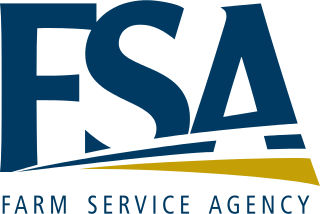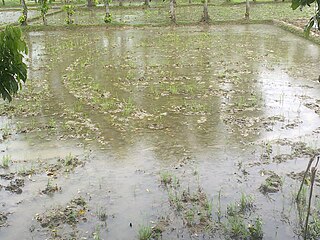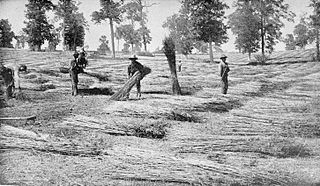
The Agricultural Adjustment Act (AAA) was a United States federal law of the New Deal era designed to boost agricultural prices by reducing surpluses. The Government bought livestock for slaughter and paid farmers subsidies not to plant on part of their land. The money for these subsidies was generated through an exclusive tax on companies which processed farm products. The Act created a new agency, the Agricultural Adjustment Administration, an agency of the U.S. Department of Agriculture, to oversee the distribution of the subsidies. The Agriculture Marketing Act, which established the Federal Farm Board in 1929, was seen as a strong precursor to this act. The AAA, along with other New Deal programs, represented the federal government's first substantial effort to address economic welfare in the United States.

The Farm Service Agency (FSA) is the United States Department of Agriculture agency into which were merged several predecessor agencies, including the Agricultural Stabilization and Conservation Service (ASCS). The ASCS was, as the FSA is now, primarily tasked with the implementation of farm conservation and regulation laws around the country. The Administrator of FSA reports to the Under Secretary of Agriculture for Farm and Foreign Agricultural Services. The current Acting Administrator is Chris Beyerhelm. The FSA (ASCS) of each state is led by a politically appointed State Executive Director (SED).
Crop insurance is purchased by agricultural producers, and subsidized by the federal government, to protect against either the loss of their crops due to natural disasters, such as hail, drought, and floods, or the loss of revenue due to declines in the prices of agricultural commodities. The two general categories of crop insurance are called crop-yield insurance and crop-revenue insurance. On average, the federal government subsidizes 62 percent of the premium. In 2014, crop insurance policies covered 294 million acres. Major crops are insurable in most counties where they are grown, and approximately 83% of U.S. crop acreage is insured under the federal crop insurance program. Four crops—corn, cotton, soybeans, and wheat— typically account for more than 70% of total enrolled acres. For these major crops, a large share of plantings is covered by crop insurance. In 2014, the portion of total corn acreage covered by federal crop insurance was 87%; cotton, 96%; soybeans, 88%; and wheat, 84%.

The Risk Management Agency (RMA) is an agency of the U.S. Department of Agriculture, which manages the Federal Crop Insurance Corporation (FCIC). The current Acting Administrator is Heather Manzano.

The Agricultural Adjustment Act of 1938 was legislation in the United States that was enacted as an alternative and replacement for the farm subsidy policies, in previous New Deal farm legislation, that had been found unconstitutional. The act revived the provisions in the previous Agriculture Adjustment Act, with the exception that the financing of the law's programs would be provided by the Federal Government and not a processor's tax, and was also enforced as a response to the success of the Soil Conservation and Domestic Allotment Act of 1936.

Agricultural land is typically land devoted to agriculture, the systematic and controlled use of other forms of life—particularly the rearing of livestock and production of crops—to produce food for humans. It is thus generally synonymous with both farmland or cropland, as well as pasture or rangeland.

The Agriculture Risk Protection Act of 2000 made major revisions to the United States' federal crop insurance program and provided emergency agricultural assistance. The crop insurance provisions significantly increased the program's government subsidy; improved coverage for farmers affected by multiple years of natural disasters; and authorized pilot insurance programs for livestock farmers and growers of other farm commodities that were not served by crop insurance, among many other provisions. The emergency provisions made available a total of $7.14 billion in emergency farm assistance, mostly in direct payments to growers of various commodities to compensate for low farm commodity prices.
Catastrophic crop insurance (CAT) is a component of the U.S. federal crop insurance program, originally authorized by the Federal Crop Insurance Reform Act of 1994. CAT coverage compensates farmers for crop yield losses exceeding 50% of their average historical yield at a payment rate of 55% of the projected season average market price. CAT coverage requires that a farmer realize a yield loss of more than 50% and only makes payments on losses exceeding the 50% threshold. Producers pay no premium for CAT coverage, but except for cases of financial hardship must pay an administrative fee of $300 per crop. A producer has the ability to purchase additional insurance coverage beyond CAT coverage, but must pay a premium, partially subsidized by the government.

The Federal Crop Insurance Reform and Department of Agriculture Reorganization Act of 1994, Pub.L. 103–354, 108 Stat. 3178, was introduced on April 14, 1994 by Eligio de la Garza (D-TX) and was signed into law on October 13, 1994 by President William J. Clinton. It consisted of two titles:
In United States agricultural policy, disaster payments are direct federal payments provided to crop producers when either planting is prevented or crop yields are abnormally low because of adverse weather and related conditions. Between 1988 and 2005, ad hoc disaster legislation was enacted for each crop year, providing a total of nearly $20 billion in direct disaster payments to farmers. These payments were made both to producers with crop insurance and those without insurance.
When a county has been declared a disaster area, by either the President or the Secretary of Agriculture, farmers in that county may become eligible for low-interest emergency disaster (EM) loans under the Emergency Disaster Loan Program.
In United States agricultural policy, the triple base plan -- also called the flexible base plan -- is a proposal under which farmers who raise program crops would receive program payments only on a certain percentage of their permitted acreage. A producer participating in a federal price support program actually would have three categories of base acres for program purposes:
The Direct and Counter-cyclical Payment Program (DCP) of the USDA provides payments to eligible producers on farms enrolled for the 2002 through 2007 crop years. There are two types of DCP payments – direct payments and counter-cyclical payments. Both are computed using the base acres and payment yields established for the farm.
In United States agricultural law, producers who grow a crop that is not eligible for crop insurance may be eligible for a direct payment under the Farm Service Agency’s Noninsured Crop Disaster Assistance Program (NAP). NAP has permanent authority under the Federal Crop Insurance Reform Act of 1994,.
Multi-Peril Crop Insurance (MPCI) is the oldest and most common form of federal crop insurance. MPCI protects against crop yield losses by allowing participating producers to insure a certain percentage of historical crop production. A single policy protects crops against all natural perils including adverse weather, fire, insects, disease, wildlife, earthquake, volcanic eruption and failure of irrigation water due to unavoidable causes. It is delivered by private companies and reinsured by the federal government.
In Canadian agricultural policy, a Gross Revenue Insurance Plan (GRIP) is a form of direct payment combining a crop insurance component and a revenue protection component. Farmers finance one-third of the premiums paid out under the revenue protection component. The GRIP makes payments when market revenue falls short of a producer’s target revenue. Target revenue per acre for an individual crop is based on historical yields, a multi-year moving average of price, and a level of insurance coverage chosen by the producer.
Ontario Agricorp is a Crown agency of the Province of Ontario that delivers risk management programs and other services to Ontario's agriculture industry.

Agriculture in India is highly susceptible to risks like droughts and floods. It is necessary to protect the farmers from natural calamities and ensure their credit eligibility for the next season. For this purpose, the Government of India introduced many agricultural schemes throughout the country.

Kentucky was the greatest producer of hemp in the United States during the 19th and 20th centuries, when it was the source of three fourths of U.S. hemp fiber. Production started to decline after World War I due to the rise of tobacco as the cash crop in Kentucky and the foreign competition of hemp fibers and finished products. In 1970, federal policies virtually banned the production of industrial hemp during the War on Drugs saying all Cannabis sativa is a Schedule I controlled substance. Federal law under the Agricultural Act of 2014 allowed research back into hemp. Kentucky began production again with 33 acres in 2014. As of 2016 harvest season, only two U.S. states other than Kentucky had over 100 acres (40 ha) in hemp production: Colorado and Tennessee. The first 500-acre commercial crop was planted in Harrison County in 2017, and research permits were issued for over 12,000 acres (4,900 ha) that year. The 2016 documentary Harvesting Liberty concerns the 21st century Kentucky hemp industry.







